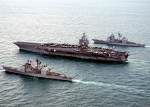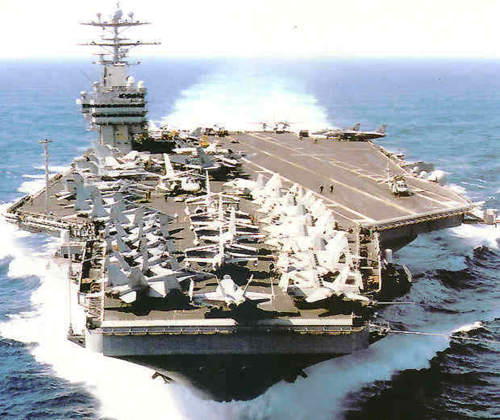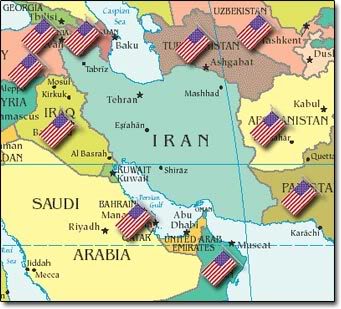Ongoing Iran War Preparations? Arabian Sea: Center Of West’s 21st Century War

The monumental expansion of arms sales and the buildup of naval and air power in the Arabian Sea region are unprecedented. They are also alarming to the highest degree.
A quarter of the world’s nuclear aircraft carriers will soon be in the Arabian Sea.

The Nimitz class nuclear-powered supercarrier USS Abraham Lincoln arrived in the region on October 17 to join the USS Harry S. Truman Carrier Strike Group, which in turn had arrived there on June 18 as part of a regular rotation.
The Charles de Gaulle, flagship of the French navy, the country’s only aircraft carrier and the sole non-American nuclear carrier, will soon join its two U.S. counterparts. The U.S. possesses half the world’s twenty-two aircraft carriers, all eleven supercarriers (those displacing over 70,000 tons) and eleven of twelve nuclear carriers.
Regarding the unscheduled deployment of a second American aircraft carrier to the region, a CBS News report stated:
“Air strikes in Afghanistan are up 50 per cent and now Defense Secretary Gates has ordered a second aircraft carrier, the USS Lincoln, into the fight.
“Two carriers operating off the coast of Pakistan means about 120 aircraft available for missions over Afghanistan. And that’s not counting U.S. Air Force missions flown out of Bagram and Kandahar.” [1]
The countries bordering the Arabian Sea are Somalia, Djibouti, Yemen, Oman, Iran, Pakistan, India and the island nation of Maldives.
USS Lincoln and USS Truman are currently assigned to the Fifth Fleet’s area of responsibility, which encompasses the Northern Indian Ocean and its branches and offshoots: The Arabian Sea, the Red Sea, the Gulf of Aden and the eastern coast of Africa south to Kenya, the Gulf of Oman and the Persian Gulf.
The nations on the Red Sea and Persian Gulf are, in addition to those mentioned above, Egypt, Eritrea, Israel, Jordan, Saudi Arabia and Sudan and Bahrain, Iraq, Kuwait, Qatar, Saudi Arabia and the United Arab Emirates, respectively.
The Fifth is the first fleet established in the post-Cold War period, recommissioned in 1995 after being deactivated in 1947. (Similarly, the Fourth Fleet, which is assigned to the Caribbean Sea and Central and South America, was reactivated two years ago after being decommissioned in 1950.)
It shares a commander and headquarters with U.S. Naval Forces Central Command (CENTCOM) at Manama, Bahrain, across the Persian Gulf from Iran. CENTCOM was the last regional military command launched by the Pentagon during the Cold War (1983) and its area of responsibility stretches across what has been referred to as the Broader Middle East from Egypt in the west to Kazakhstan, bordering China and Russia, to the east.
The Fifth Fleet and Naval Forces Central Command are jointly in charge of five naval task forces operating in and near the Arabian Sea which patrol several of the most strategic chokepoints on the planet: The Suez Canal linking the Mediterranean Sea, where the U.S. Sixth Fleet and the North Atlantic Treaty Organization’s Operation Active Endeavor hold sway, to the Red Sea. The Bab Al Mandeb connecting the Red Sea with the Gulf of Aden. The Strait of Hormuz between the Gulf of Oman and the Persian Gulf.
Combined Task Force 150 (CTF-150) is a multinational naval group established in 2001 with logistics facilities in the Horn of Africa nation of Djibouti and operates from the Strait of Hormuz to the Gulf of Aden and past the Bab Al Mandeb to the Red Sea and south to the Indian Ocean nation of Seychelles. Last year the Pentagon secured a military facility in Seychelles, its second in an African nation, where it has deployed Reaper unmanned aerial vehicles (drones), PC-3 Orion anti-submarine and surveillance aircraft, and 112 Navy personnel. Other nations currently contributing ships and personnel to CTF-150 are Britain, Canada, Denmark, France, Germany, Pakistan, South Korea and Thailand. Recent participants also include Australia, Italy, the Netherlands, New Zealand, Portugal, Singapore, Spain and Turkey.
Combined Task Force 151 (CTF-151) was launched in January of 2009, operates in the Gulf of Aden and the Somali Basin and covers an area of 1.1 million square miles. Twenty nations are scheduled to participate in the U.S.-led task force and Britain, Canada, Denmark, France, the Netherlands, Pakistan, Singapore, South Korea and Turkey have already enlisted. Its commanders to date have been from the U.S., Britain, South Korea and Turkey.
Combined Task Force 152 (CTF-152) operates from the northern Persian Gulf to the Strait of Hormuz, between the areas of responsibility of CTF-150 and CTF-158, and is part of Operation Iraqi Freedom.
Combined Task Force 158 (CTF-158) operates in the northern-most part of the Persian Gulf, is also part of Operation Iraqi Freedom, and consists of British and Australian as well as U.S. ships. Its main tasks are to oversee Iraqi oil installations and to create an Iraqi navy under the Pentagon’s control.
The U.S. has divided the world between six regional military commands and six navy fleets. The Arabian Sea is covered by three of the Pentagon’s overseas military commands – Central Command, Africa Command and Pacific Command – to provide an indication of the importance attached to the region.
In addition to the Fifth Fleet’s and Naval Forces Central Command’s headquarters in Bahrain, Central Command also maintains command, forward deployment, air and training bases and facilities in Kuwait, Oman, Qatar and the United Arab Emirates in the Persian Gulf in addition to 56,000 troops and air, naval and infantry bases in Iraq.
Several months before the September 11, 2001 attacks in New York City and on the Pentagon, the U.S. signed an agreement with the small nation of Djibouti (with a population of 725,000) to take over a former French base, Camp Lemonnier, which is now a United States Naval Expeditionary Base hosting the Combined Joint Task Force – Horn of Africa, assigned to Africa Command since the latter was activated two years ago. The Combined Joint Task Force – Horn of Africa’s area of responsibility takes in Djibouti, Ethiopia, Eritrea, Kenya, Seychelles, Somalia, Sudan, Tanzania, Uganda and Yemen, with the Indian Ocean nations of Comoros, Mauritius and Madagascar effectively included.
In early 2002 the U.S. deployed 800 special operations troops to Camp Lemonnier to conduct covert operations in Yemen across the Gulf of Aden from Djibouti. There are now in the neighborhood of 2,000 U.S. troops in the country and 3,000 French troops there in what has been described as France’s largest overseas military base. In the beginning of this decade Germany deployed 1,200 troops to Djibouti along with forces from Spain and the Netherlands. Britain added troops in 2005.
In total, there are as many as 8-10,000 military personnel from NATO nations in Djibouti. The Pentagon has used Camp Lemonnier, the port of Djibouti and the country’s international airport for attacks in Yemen and Somalia, and French troops in the country assisted Djibouti in its armed conflict with neighboring Eritrea in 2008. France uses the country to train its troops for the war in Afghanistan and the Pentagon used it to support the Ethiopian invasion of Somalia in 2006.
The U.S. Fifth Fleet ordinarily has one aircraft carrier, serving as the nucleus of a carrier strike group, assigned to it. With USS Lincoln joining USS Truman in the Arabian Sea this month it now has two. USS Lincoln is accompanied by a guided missile destroyer and “brings more than 60 additional aircraft to the theater in support of Operation Enduring Freedom.” [2]
USS Truman’s strike group includes four Aegis class destroyers equipped for Standard Missile-3 anti-ballistic missiles, a guided missile cruiser and the German frigate FGS Hessen. Carrier Wing 3 attached to the aircraft carrier includes three strike fighter squadrons, a Marine fighter attack squadron, and airborne early warning, electronic attack and helicopter anti-submarine squadrons.
Since passing though the Suez Canal on June 28 until late last month Carrier Wing 3 had “completed more than 3,300 aircraft sorties and logged more than 10,200 flight hours, with more than 7,200 of those hours in support of coalition ground forces in Afghanistan.” [3] There are 7,000 sailors and marines attached to the USS Truman carrier strike group.
Beforehand, shortly after entering the Mediterranean Sea in May, USS Truman engaged in joint interoperability exercises in Marseille with its French fellow nuclear aircraft carrier Charles de Gaulle. French warplanes landed on the Truman’s deck and American ones on Charles de Gaulle’s.
The French carrier was returned to port for repairs on the day it set sail for “a four-month mission to support the fight in Afghanistan,” but “will recover lost time at sea and its itinerary is not likely to change.”
Its new mission, the first since 2007, “is to take it to join the fight against piracy off Somalia in the Indian Ocean and the NATO mission in Afghanistan.
“The new mission of the ship is to join the fight against pirates that is taking place off the coast of Somalia in the Indian Ocean [where a] NATO mission is ongoing.” [4] Nuclear aircraft carriers are a curious choice for contending with piracy.
The NATO deployment in question is Operation Ocean Shield, inaugurated in August of 2009 and extended to the end of 2012. Standing NATO Maritime Group 1 and Standing NATO Maritime Group 2, which have also visited Bahrain, Kuwait, Qatar and the United Arab Emirates and participated in joint naval maneuvers with Pakistan on the eastern end of the Arabian Sea, rotate for the operation in the Gulf of Aden.
The U.S.’s Operation Enduring Freedom encompasses sixteen nations in all – Afghanistan, Pakistan, Uzbekistan, Cuba (Guantanamo Bay), Djibouti, Eritrea, Ethiopia, Jordan, Kenya, Kyrgyzstan, the Philippines, Seychelles, Sudan, Tajikistan, Turkey and Yemen – and NATO’s efforts parallel and reinforce the Pentagon’s across the width of the Arabian Sea from the Horn of Africa to South and Central Asia.
At its summit in Istanbul, Turkey in 2004, NATO launched the Istanbul Cooperation Initiative to build military partnerships with the six member states of the Gulf Cooperation Council – Bahrain, Kuwait, Oman, Qatar, Saudi Arabia and the United Arab Emirates – and has conducted military exchanges and cooperation with them in the interim. [5] The United Arab Emirates has supplied NATO with troops for the war in Afghanistan and hosts a secret air base for the transit of troops and equipment to the war zone.
In May of 2009 French President Nicolas Sarkozy opened a military base in the United Arab Emirates, the first permanent French base in the Persian Gulf and the first overseas base in 50 years. Including a navy and air force base and a training camp, it was seen at the time as a show of force against Iran which contests the Abu Musa island in the Persian Gulf with the Emirates.
NATO forces also operate out of bases in Kyrgyzstan, Tajikistan and Uzbekistan. The North Atlantic Alliance has launched several helicopter gunship attacks inside Pakistan since late last month and on September 30 killed three Pakistani soldiers.
There are 120,000 troops from almost 50 nations serving under NATO’s International Security Assistance Force in Afghanistan.
This year NATO has airlifted Ugandan troops to Somalia for the armed conflict there.
The Charles de Gaulle aircraft carrier en route to the Arabian Sea to support the war in that country as well for operations off the coast of Somalia was commissioned in May of 2001. Seven months later it sailed to the Arabian Sea to support Operation Enduring Freedom and the war in Afghanistan. On December 19 of that year Super Étendard attack jets and Rafale Ms fighters took off from its deck to conduct bombing and reconnaissance missions, in all over 140.
The following March Super Étendard and Mirage warplanes assigned to Charles de Gaulle carried out air strikes before and during the U.S.-led Operation Anaconda.
When the French carrier arrives in the Arabian Sea this month it will be accompanied by two frigates, an attack submarine and a refuelling tanker, 3,000 sailors and 27 aircraft: Ten Rafale F3 fighters, 12 Super Étendard attack jets, two Hawkeye early warning planes and three helicopters.
According to the commander of the group, Rear Admiral Jean-Louis Kerignard, “the force would help allied navies fight piracy off the coast of Somalia and send jets to support NATO in the skies above Afghanistan.
“The ships will also train alongside allies from Saudi Arabia, India, Italy, Greece and the United Arab Emirates and make two stopovers at the French base in Djibouti before returning to France in February 2011.” [6]
With USS Lincoln and the USS Truman carrier strike group, there will be three carriers, ten other ships, an attack submarine and as many as 150 military aircraft in the Arabian Sea. That is in addition to the five warships of the NATO Maritime Group 1 in theater, 14-15 ships with CTF-150 and perhaps dozens more with CTF-151, CFT-152 and CTF-158. A formidable armada covering the sea from one end to the other.
In the north of the Arabian Sea, the Gulf of Oman and into the Persian Gulf, on October 21 the U.S. announced a $60 billion arms deal with Saudi Arabia for advanced fighter jets, helicopters, missiles and other weaponry and equipment,” according to a Western news agency “the largest US arms deal ever.” [7]

US military bases surround Iran
Last month the Financial Times disclosed that Washington plans to sell $123 billion worth of weapons to Saudi Arabia, Kuwait, Oman and the United Arab Emirates. This January reports surfaced of White House plans to sell Patriot missile batteries to Bahrain, Kuwait, Qatar and Saudi Arabia. The U.S. Navy also patrols the Persian Gulf with Standard Missile-3 interceptor missile-equipped warships. [8]
On the eastern end of the Arabian Sea, on October 23 Secretary of State Hillary Clinton announced a $2 billion, five-year military aid package for Pakistan, and President Obama’s scheduled visit to India next month is reported to include massive arms deals that will effect the U.S. supplanting Russia as India’s main weapons supplier.
The monumental expansion of arms sales and the buildup of naval and air power in the Arabian Sea region are unprecedented. They are also alarming to the highest degree.
The West, America and its NATO allies, are escalating military operations across the area, from Asia to Africa to the Middle East. The theater of operations has recently broadened from South Asia to the Arabian Peninsula with drone and helicopter attacks in Pakistan and air and cruise missile strikes in Yemen.
A war that started at the beginning of the century is in its tenth year and gives every indication of being permanent.
Notes
1) CBS News, October 18, 2010
2) Navy NewsStand, October 17, 2010
3) Navy NewsStand, September 26, 2010
4) Associated Press, October 14, 2010
5) NATO In Persian Gulf: From Third World War To Istanbul
Stop NATO, February 6, 2009
http://rickrozoff.wordpress.com/2009/08/26/nato-in-persian-gulf-from-third-world-war-to-istanbul
6) Expatica, October 13, 2010
7) Deutsche Presse-Agentur, October 21, 2010
8) U.S. Extends Missile Buildup From Poland And Taiwan To Persian Gulf
Stop NATO, February 3, 2010
http://rickrozoff.wordpress.com/2010/02/03/u-s-extends-missile-buildup-from-poland-and-taiwan-to-persian-gulf
Stop NATO
http://groups.yahoo.com/group/stopnato
Blog site:
http://rickrozoff.wordpress.com/
To subscribe, send an e-mail to:
[email protected]
or
[email protected]
Daily digest option available.


